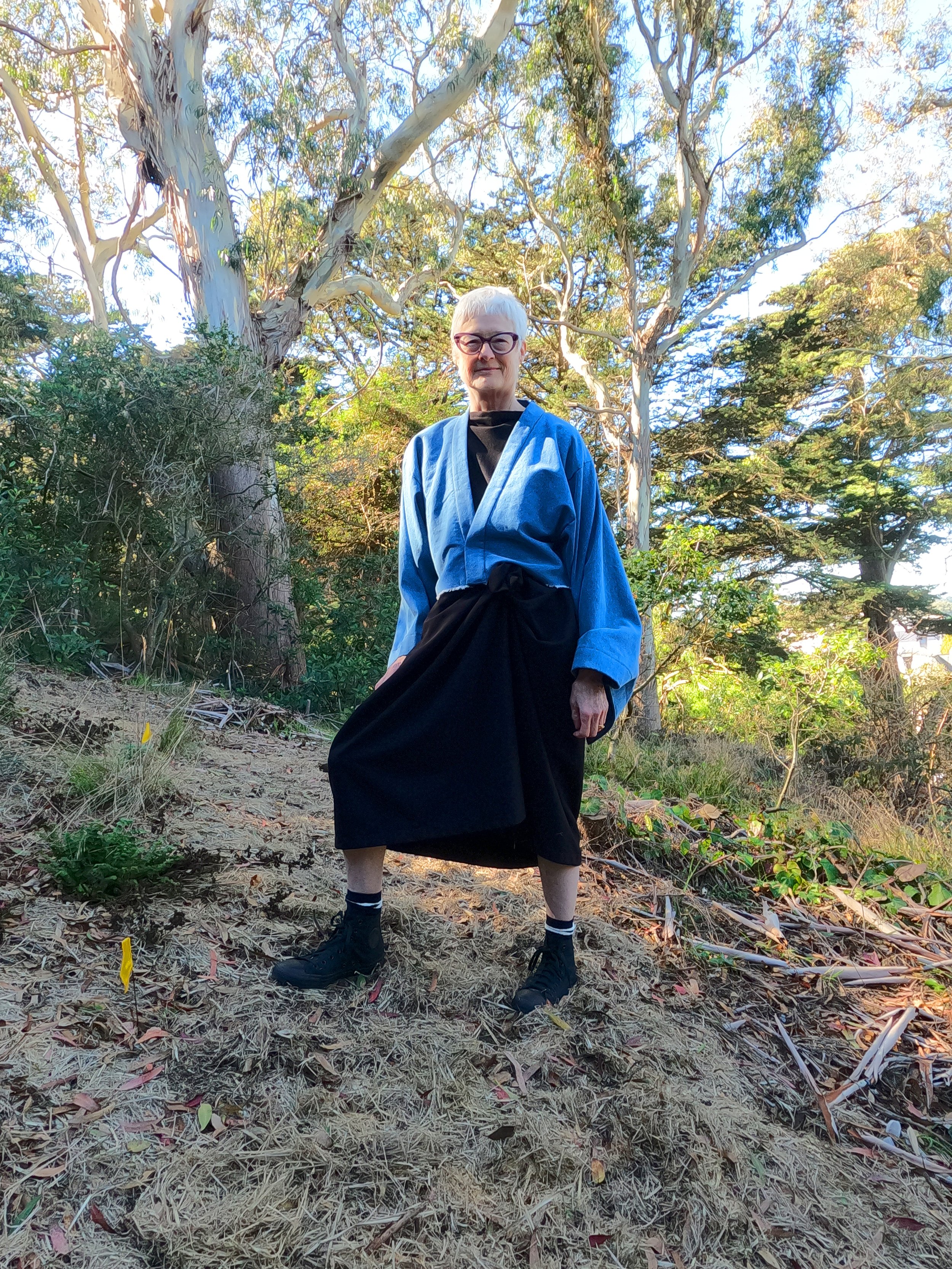The Artists of the Secret Meadow
Photographs by Akiko Tsuji
Renée, Alicia, and Cheryl in the denim happy coats and cropped jacket over the sculpted dresses.
Alicia Escott, Renée Rhodes, and Cheryl Meeker
On a brisk, late October morning, I met with the artists Alicia Escott, Renée Rhodes, and Cheryl Meeker at Buena Vista Park in San Francisco. I wanted to learn more about these three amazing women and their long-term mission to restore and preserve nature increasingly at risk by the world’s lack of addressing small and large environmental urgencies. This photo shoot is part a documentary and part a fashion editorial. It seemed such a fitting concept as I always make clothes with inspiring artists in mind.
Alicia in Simone dress.
Established in 1867, Buena Vista Park is the oldest park in San Francisco. It has been home to an abundance of trees, some indigenous to this region such as coast oak, toyon, coyote brush, and some not, like the eucalyptus, ehrharta grass, foxtail grass, ivy, and blackberry. The park stretches across 36 acres in central San Francisco with its peak at 575 feet above sea level giving a stunning view of the city including the Golden Gate Bridge, the Pacific Ocean, and Golden Gate Park. Even from the mid-section of the steep hill, one can get glimpses of quite pretty views of the city - layers of washed pastel-colored buildings reflecting the sunlight into the distance through the openings of the oak trees.
Renée wears Art Scarf D and Billow dress.
During the pandemic, Alicia and Renée took the baton from a friend who started this particular site restoration, and Cheryl came on board when they realized they were all thinking about convergent projects with oak ecologies. “We all live close to the park so this volunteer work is a meaningful way to give back and live in reciprocity to the land we share.” These artists’ ultimate goal for this site restoration is that what they plant and care for will eventually be fully able to thrive within the natural water cycle in San Francisco and become drought tolerant.
Cheryl wears cropped denim jacket and wool One Flower dress.
A short walk from the playground, the restoration site is slightly shielded away from the trail on a slope that is mostly covered with a bed of soft plants. Even in October and it has been dry, perhaps due to the frequent dense fog, the oak leaves and the surrounding plants were still quite green. Renée mentioned that much of the plants they planted amidst the grasses are perennial plants – horkelia, yarrow, coast buckwheat, and Douglas iris. When the late morning sun started to peek through the trees, the grasses shined golden.
Alicia wears Art Scarf B and Simone dress.
The small yellow flags spread around the center of the site indicating where California fescue and purple needlegrass were planted. According to the group, they are drought-tolerant native California grasses that have deep root systems which can sequester carbon from our air and bury it deep in the land similar to a tree but are more resilient to a future with hotter fires. “This rainy season, we will be working with the Naturals department to select other plants to build the diversity in the meadow," says Alicia.
Alicia finds an oak sapling. Wears the Reversible Artist Denim Happy Coat.
One day a week, the artists would gather here and pull the weeds around, water them if they were just transplanted out of season, and keep their eyes out for any disturbance to the straw ground cover they have put down from coyotes or other animals including humans. Near it was a mid-sized grown spiraling bark of one oak tree that caught my eye. On its bark, there was a sapling, and this was "stump sprouting" meaning its growing forth was from a still-living root system from a tree that had been cut down. As I looked up, it was fascinating to see the even more spiraling barks and branches spreading out into the sky.
Cheryl, Renée and Alicia in sculpted dresses.
A jay came by around us surprisingly close, and I was told that it was expecting a feed from the acorns recently ripened. As we walked around, there was a small oak sapling from the ground. The group explained to me that it was acorn-sprouted, and "likely a local scrub jay buried an acorn there (to eat it later) from the tree behind it and forgot about it. This is often how oaks are propagated."
A view from Buena Vista Park
Each of the artists has made ecological-related work over the years and has increasingly incorporated habitat restoration and regeneration topics into their practices. "The line there is blurry for each of us. We have let this project unfold without defining it, and I think we are unsure if for us it is an art project or just habitat restoration. What we do know is that our weekly meetings are regenerative, that we feel we are building community together, and with our contacts at the park through moving our bodies and being in dialogue — but we are also building non-human community relationships and that it feels good. I am personally increasingly interested in a practice that makes art for both human and non-human audiences. I am interested in letting this work unfold over the years and not defining its purpose before it is ready."
THE ARTISTS
Alicia Escott is an interdisciplinary artist based in the land currently called San Francisco. She/they practices in solidarity with thinkers across fields undoing the construct of “nature” as a thing separated from us and our world. @alicia_escott
Renée Rhodes creates social sculptures, videos, books, gardens, and walks that explore geological empathy, mimicry, and the creation of place-based memory through somatic practices. @reneearhodes
Cheryl Meeker is a visual artist working in a variety of media, touching on the fundamentals of sustenance in our economically and environmentally destabilized world. @cherymeeker








